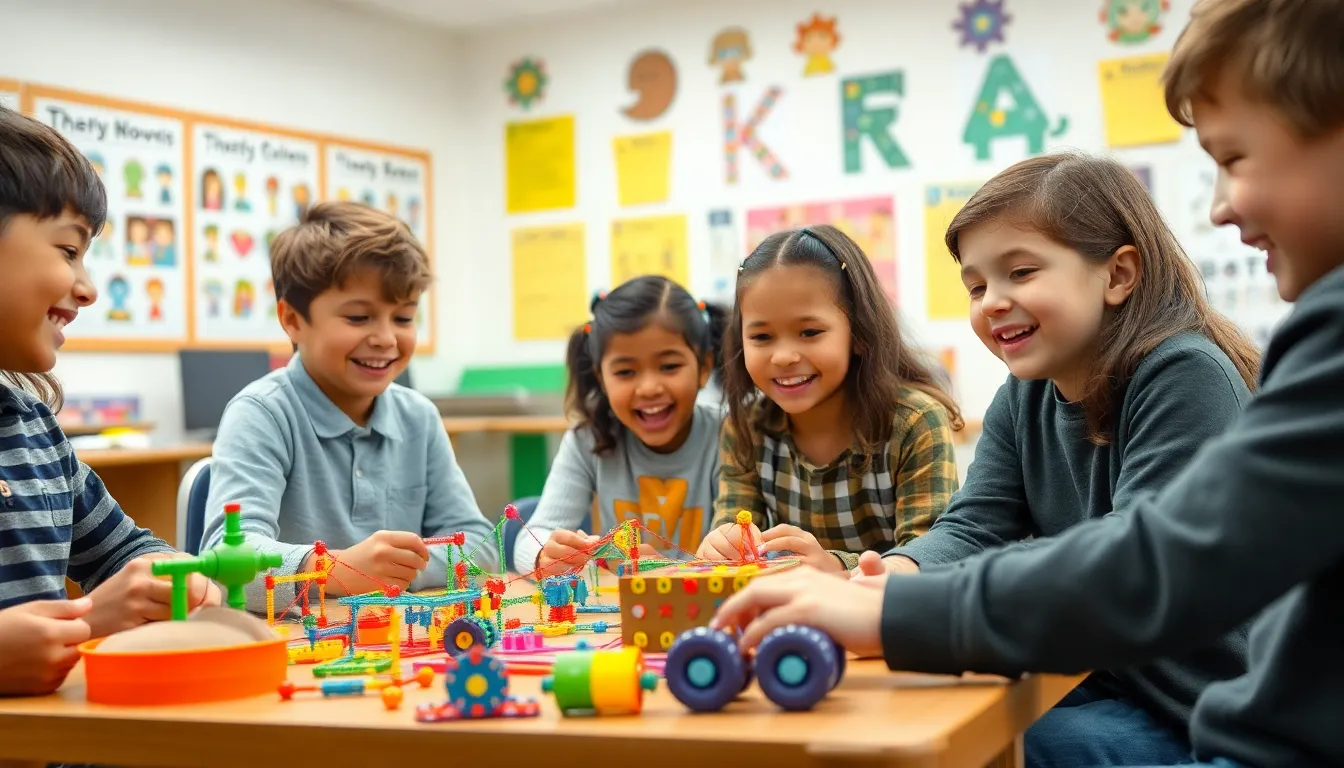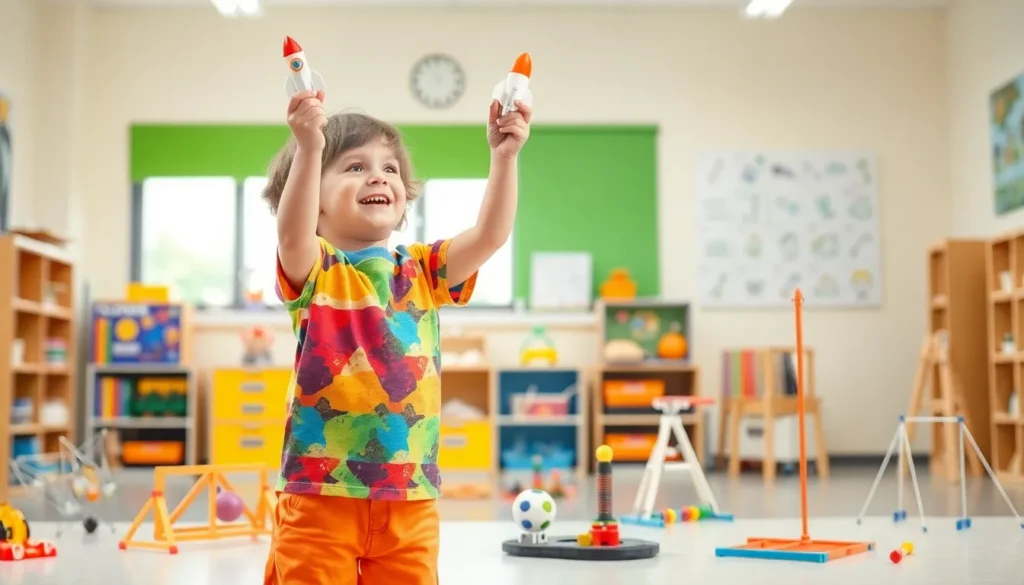Physics toys are the ultimate blend of fun and learning, transforming complex concepts into playful experiences. Imagine launching a rocket that defies gravity or watching a pendulum swing while contemplating the mysteries of motion. These toys not only entertain but also ignite curiosity about the physical world, making them perfect for kids and adults alike.
Table of Contents
ToggleOverview of Physics Toys
Physics toys offer a playful way to explore scientific concepts. They transform theoretical principles into hands-on activities, captivating users of various ages. Examples include simple machines like levers and pulleys, along with advanced constructs such as gyroscopes and solar-powered cars. With such variety, these toys appeal to both children and adults, promoting a deeper understanding of physics.
Different categories of physics toys exist, each targeting specific concepts. Kinetic art demonstrates energies through captivating moving sculptures. Magnetic toys explore the forces of attraction and repulsion, providing tactile experiences. Building kits encourage critical thinking and problem-solving skills, fostering an early interest in engineering and design.
Educational settings often utilize physics toys for engaging classroom experiences. Teachers introduce simulations of gravity and friction through interactive models. Students enhance their knowledge through experimentation and play, leading to exciting discoveries. Parents can also integrate these toys at home, reinforcing lessons taught in school.
Moreover, physics toys spark creativity. Users can invent their own experiments and modifications, leading to unique projects. Collaborating with peers or family members on these projects enhances social skills while maintaining a focus on learning. With an emphasis on fun, curiosity grows, making complex ideas more accessible and enjoyable.
Ultimately, physics toys bridge the gap between play and education. They provide valuable insights into scientific principles, leaving a lasting impression on young minds. Engaging with these toys cultivates a strong foundation for lifelong learning and exploration of the physical world.
Benefits of Using Physics Toys

Physics toys offer multiple benefits that enhance learning and engagement. Users experience a unique combination of enjoyment and educational value, making these tools essential for discovering scientific principles.
Educational Advantages
Physics toys play a significant role in education by simplifying complex topics. They introduce concepts such as motion, energy, and forces in a practical manner. Hands-on experience reinforces lessons learned in traditional settings, ensuring that students remember key ideas. Engaging with toys like building kits and solar-powered cars instills a deeper understanding of how theories apply in the real world. The interactive nature encourages independent exploration, fostering a love for science.
Development of Critical Thinking
Critical thinking skills flourish when children engage with physics toys. Problem-solving arises naturally as they encounter challenges during play. Constructing simple machines or experimenting with pendulums allows them to analyze outcomes. Each interaction invites users to make predictions, test hypotheses, and adjust strategies based on results. These experiences sharpen analytical skills, promoting adaptability and creativity in approaching various problems. Enhancements in critical thinking lead to greater academic success, equipping individuals for future challenges.
Types of Physics Toys
Physics toys come in various forms, each designed to engage users while teaching fundamental scientific principles. They range from classic options to modern innovations that captivate users of all ages.
Classic Toys
Classic physics toys include timeless favorites like tops, yo-yos, and marbles. Tops demonstrate principles of angular momentum and stability. Yo-yos illustrate gravitational and kinetic energy through their movement. Marbles encourage exploration of concepts like momentum through simple games and experiments. Each of these toys not only entertains but also introduces the fundamental laws of motion, making them popular educational tools.
Modern Innovations
Modern innovations in physics toys leverage advanced technology to enhance learning experiences. Solar-powered cars exemplify how solar energy converts into kinetic energy, showcasing renewable resources. Magnetic construction sets allow users to explore magnetism and geometry creatively. Another example is robotics kits, which send users on a journey through engineering and programming concepts. These toys foster critical thinking and collaboration, providing hands-on engagement with contemporary scientific ideas.
Popular Physics Toy Examples
Physics toys come in various forms, each designed to engage users with scientific concepts. These toys not only entertain but also educate, making them a favorite among educators and parents alike.
Building Kits
Building kits stand out for their ability to inspire creativity while teaching engineering principles. They typically include pieces for constructing structures, vehicles, or machines. Popular kits like LEGO Technic and K’NEX allow users to experiment with physics concepts, such as balance and structural integrity. Users can create complex models that demonstrate real-world applications of force, motion, and stability. Engaging with these kits enhances spatial awareness and problem-solving skills. By assembling and disassembling structures, individuals gain a hands-on understanding of how components interact, reinforcing lessons learned in educational settings.
Simple Machines
Simple machines are essential physics toys that illustrate basic mechanical principles. Examples include levers, pulleys, and inclined planes. Each machine reduces the effort needed to perform tasks, making them practical for understanding work and energy. The classic example of a lever enables users to lift heavy objects with minimal force. Children can explore how pulleys lift loads or how inclined planes facilitate movement. Engaging with these toys encourages experimentation, allowing individuals to discover the impact of different configurations. Through hands-on play, users develop a foundational grasp of mechanical advantage, which is vital for advancing in physics and engineering concepts.
Tips for Choosing the Right Physics Toy
Select toys that align with specific age groups. Toys designed for younger children often emphasize simple mechanisms, while those for older kids can explore complex concepts. Prioritize safety by ensuring toys are made of non-toxic, durable materials that can withstand regular use.
Consider the educational value of the toy. Look for products that demonstrate clear physics principles, such as motion, energy, or forces. Hands-on kits, such as building sets, encourage creativity and problem-solving.
Evaluate the level of interactivity. Engaging toys create opportunities for experimentation and discovery. Physics toys that allow for modifications or challenges stimulate critical thinking skills.
Investigate user reviews and ratings. Feedback from other customers provides insights into the toy’s effectiveness and longevity. High ratings often reflect a toy’s ability to captivate interest and maintain engagement.
Explore recommendations from educators and experts. Teachers frequently share insights on which toys best support learning objectives. Some toys may complement school curricula, reinforcing concepts taught in class.
Assess the compatibility with other toys. Some physics toys integrate well with existing collections, enhancing the play experience. Building kits that connect with popular brands can lead to expansive creative projects.
Reflect on personal interests or areas of curiosity. Selecting toys that pique interest can increase engagement and enthusiasm. Choose kits that align with individual passions, such as robotics or astronomy.
Involve kids in the decision-making process. When children express their preferences, they often exhibit greater enthusiasm when playing with the chosen toy. Collaboration in selecting a toy fosters excitement and encourages a deeper exploration of physics principles.
Physics toys serve as an invaluable resource for fostering curiosity and understanding of scientific principles. They engage users of all ages while simplifying complex topics into enjoyable experiences. By combining play with learning, these toys encourage creativity and critical thinking, making them essential tools in both educational settings and at home.
As individuals explore the world of physics through hands-on activities, they not only grasp fundamental concepts but also develop problem-solving skills that are crucial for future success. Whether through classic options or modern innovations, physics toys create a dynamic environment for exploration and discovery, paving the way for a lifelong passion for science.






